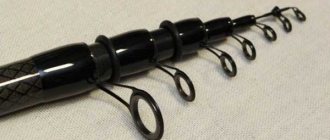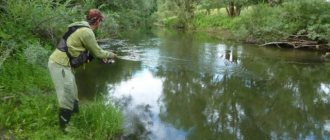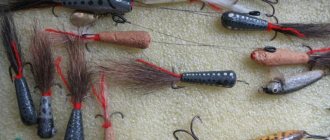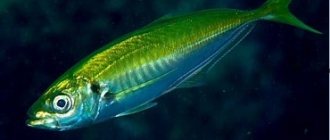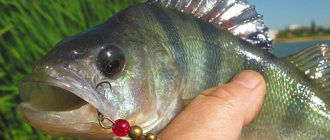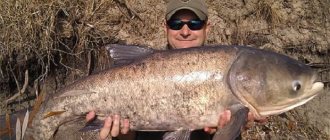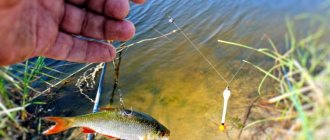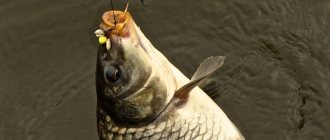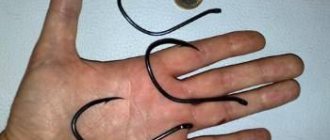How the half-bottom is equipped
A distinctive feature of this gear is that during fishing the main equipment is located at the very bottom. Namely, many species of fish live here and they rush here in search of food.
The lower part of a half-bottom fishing rod is equipped like a regular bottom fishing rod - with a sinker and a hook on a fishing line, which are constantly located at the very bottom. All that remains of the float tackle is the float, which is installed above the surface of the water. Therefore, such tackle received a clear definition - half-bottom.
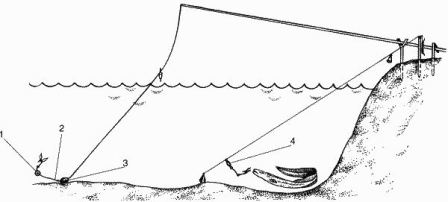
We also recommend reading:
Budget spinning reels Riobi Exiya Features of crucian carp killer gear and how to make such equipment Diagram of how to learn how to tie a hook to a fishing line Features of fishing with a retractable leash, selection of gear and installation
Half bottom for spring fishing
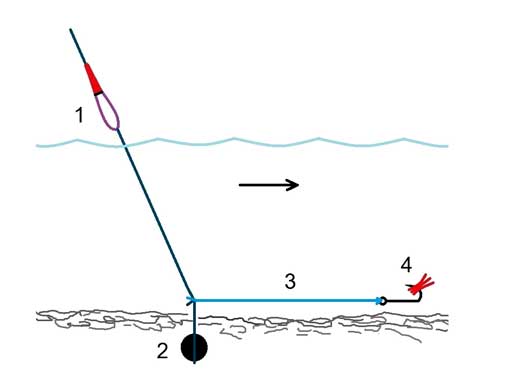
The half-bottom rig for spring fishing on soft river soil is shown in the drawing. The difference between homemade bottom gear and the previous assembly is a different method of attaching the weight (sinker) and the location of the leash on the fishing line.
And, by the way, in real conditions of spring fishing on silty soft ground, the sinker of a half-bottom of any design can fall deep into the silt. So, only the leash will remain visible above the ground from all the equipment.
As a half-bottom sinker, a homemade lead ball sliding on the short end of the main line is used with a weight sufficient to quickly sink and hold the bait at the bottom of a fast-flowing spring reservoir.
The principle of equipping a half-bottom in the spring and a side-bottom in the summer, as well as the methods of catching fish in a stream of bait washed out of the feeder, can be absolutely the same. The places from which fishing is carried out on the current are different. This could be the bank of a river or the side of a boat.
The only condition for successful spring fishing with a half-bottom is that there must be a strong current in the fishing area, which will be useful for washing food out of the soft mesh feeder used in conjunction with the half-bottom equipment.
Thickness, length of fishing line of half-bottom leash
As the main fishing line on my half-bottoms, I use a vein with a thickness of 0.2-0.22 mm that has been checked for no damage. For fishing in the summer I leave the same equipment. A leash made of fishing line 0.16-0.18 mm thick is tied 12-15 centimeters above the round sinker.
The length of the leash on my half-bottoms, configured for spring fishing, reaches half a meter. With a long line, a more movable nozzle on the hook of the tackle becomes better visible when fishing in not very clear spring water.
If you would like to learn more details about homemade bottom gear, I advise you to open the topic Onboard Donka.
Sinkers for half-bottoms
An important part of the half-bottom equipment is the sinker, the weight of which depends on:
- casting distance,
- current forces,
- fishing line sections.
The best option for fishing with a half-bottom is when the load is completely on the bottom. When choosing gear from the water, sinkers can get caught, so their different shapes allow you to distribute the weight in such a way as to avoid this unwanted moment.
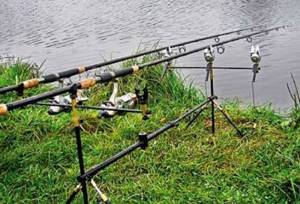
It is possible to use several weights (3-4 pieces), which are located close to each other (2-3 cm). If the current begins to intensify, then only a couple of sinkers will come off the bottom; as soon as the current decreases a little, they will return to the bottom again.
Such equipment is in constant readiness and any, even the most careful bite, will be noticed. If the equipment is not loaded enough, it will be washed ashore or lifted to the upper layers. For additional weight, you can use lead plates. Sometimes the sinker is installed at the end of the line, and the leash follows higher. The best option is to place a small sliding sinker on the working line up to the leash.
Adjust the tackle
The rod is telescopic (5 m), without guide rings and a reel. At the top of the telescope there is a metal loop, through which I attach the equipment using the “loop-to-loop” method. There are several accessories in stock, each wound on a plastic reel. Having several equipment, you can quickly change them depending on the fishing conditions, the size and type of biting fish. The most “powerful” equipment (for bream): main fishing line 0.25 mm, a leash 15-20 cm long made of 0.2 mm fishing line, thin “Soviet” hook N7. The most “delicate” equipment (for roach, white bream): main line 0.15 mm, leader 0.1-0.12 mm, “Soviet” hook N4. Between these levels of “roughness and tenderness” there are two more options for different equipment. The length of the line on all rigs is the same - 40 cm longer than the rod.
Sinkers are lead “olives” weighing from 8 to 15 g. I attach the float to the main line with two nipple rings on top and bottom (can be quickly replaced if necessary). I believe that a float for a half-bottom should have the least amount of windage in the wind, so I choose a spindle-shaped shape with a length of no more than 10 cm - these are capable of transmitting the most careful bites. The weight of the float does not exceed 3 g. The working position of the float is 30 cm from the tip of the rod.
Which rod is better for half-bottom fishing?
For a half-bottom, you can use a regular telescopic rod 5-6 m long, equipped with guide rings, as well as a reel with a reserve of fishing line, allowing you to adjust its length for long casts.
For casting, the prepared supply of fishing line is placed on the ground, and in such a way that when casting it moves freely behind the load, and part of the fishing line with the equipment is held in the hand. With the other hand, the rod is lifted from the stand, the rig is swung and sent with a smooth movement forward. But when fishing for fish, the rod is not used, and you have to fish out the prey using the fishing line. Therefore, a regular rod 5-6 meters long is quite suitable for a half-bottom.

Float for spring bream fishing

A drawing of a composite float for catching bream in spring is shown in the picture. The peculiarity of the float device is that it is able to support the weight of a weighted load, which facilitates long-distance casting of the nozzle, without losing sensitivity to bream bites.
Making and setting up a float is described in the topic “Homemade float for catching bream.” Of course, gear with composite floats of a similar design are used not only for spring fishing and not necessarily for catching bream, but they have several significant limitations in use, of which I will highlight the main ones.
For catching bream with gear equipped with a composite float with an antenna sensitive to fish bites, only reservoirs with no or very weak current are suitable. For spring fishing, these are lakes, oxbow lakes, reservoirs, and small river bays. Nozzles should be of animal origin.
Features of fishing with a sensitive float
As for catching bream with a sensitive float, for effective fishing you will need to find a section of a reservoir with a flat horizontal bottom, which is not so easy to do in the spring. Or you will have to constantly demonstrate the ability to accurately cast a float over long distances.
When fishing in the spring with a float in windy weather, far from the shore, the bream bite becomes unnoticeable.
In addition, for spring fishing in the areas of reservoirs listed above, in addition to a fishing rod with a float, other gear that is more promising for catching bream is suitable, one of which is a fishing elastic band.
Perhaps better than other gear for spring fishing for bream from a steep river bank at any current pressure, a half-bottom fishing rod with an end rig lying on the bottom or slightly raised above the ground is suitable.
Float selection
The float for the half-bottom should be selected in such a way that its weight gives the fishing line a certain bending angle, then any touch of the fish to the nozzle will tighten the fishing line and set the float in motion. Therefore, the floats used are quite heavy, which have a traditional elongated shape, with one or two attachment points. Instead of a float, you can use bells and various signaling devices; after attaching them, it is again necessary to form an obtuse angle with the fishing line.
Half-bottom feeder for spring fishing
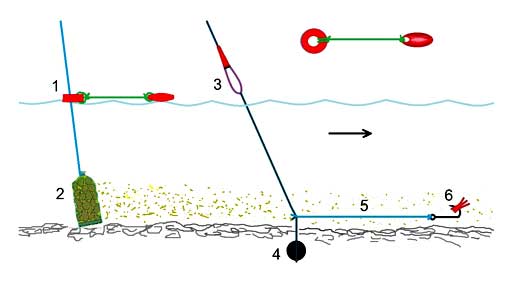
A half-bottom feeder for baiting a fishing spot during spring fishing on the current from the river bottom consists of a mesh container with bait and an additional link - a homemade device in the form of a ring, a float and a fishing line connecting them. See drawing, item 1.
A view of the foam ring and float is shown in the drawing at the top right. And the half-bottom feeder is equipped very simply.
First, we fill the soft feeder with bait mixture, then thread a nylon cord with a diameter of 1.5-2 mm or a fishing line about 1 mm thick into the hole of the foam ring and tie the insurance to the neck of the feeder.
At this point, the equipment of the feeder for catching fish with a half-bottom can be considered complete. All that remains is to tie a homemade mesh device filled with food to some kind of strong whip of suitable size and throw or lower the feeder to the desired place in the current.
The foam ring “1” with a homemade float attached to it will show the direction of the stream of food being washed away from the feeder. We need to set up a half-bottom float downstream, about a meter from the feeder or a little lower, and start fishing.
In principle, when fishing in spring from a steep bank near the river bank, you can completely abandon the homemade indicator float device sliding along the cord of the feeder.
Features of fishing with a half-bottom
Half-bottom fishing can be done throughout the open water season, but the most effective fishing occurs in spring and early summer. Since this tackle is quite coarse, in clear summer water it is less likely to catch well-fed fish. In the spring after spawning, exhausted fish are not picky and less cautious, so fishing with a half-bottom is more successful and effective.

It is better to use maggots and worms as bait during this period. When the gear is ready, they are cast across the river; after some time, the current will set the line in a straight line from the nozzle to the float. The guard should be located at a distance of 10-20 cm from the surface of the water. If no bite is observed, you should move to the side and make a “recast”.
When a fishing spot is discovered, you can position yourself thoroughly, cast to the fishing point and patiently wait for a bite. You should not hook immediately, but wait a little, since the bait for the half-bottom is usually used large, and the fish needs time to swallow it. We recommend reading the article on how to make a donk from a spinning rod.
Choosing a place for fishing with half-bottom
The presence of light sinkers in the tackle indicates that the half-bottom is not intended for long casts. In any case, the current will carry the equipment to the shore if it does not catch on an underwater obstacle. Therefore, the most important step in fishing tactics with this fishing rod will be the search for a promising place near the coastline. Particular attention should be paid to steep banks at channel turns with whirlpools and reverse currents, holes near the shore, and clean areas among aquatic vegetation and bushes. It is in such places that large fish come in search of food. In spring and autumn, bites can occur throughout the daylight hours, and in summer, fishing is most promising at morning and evening dawn, as well as at night.
